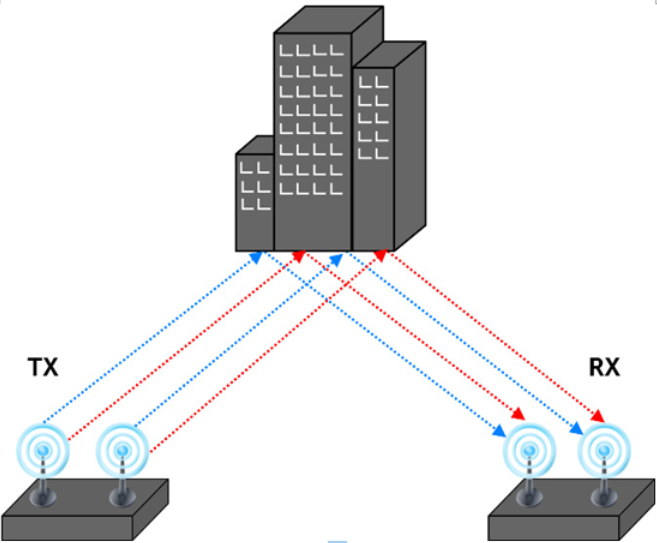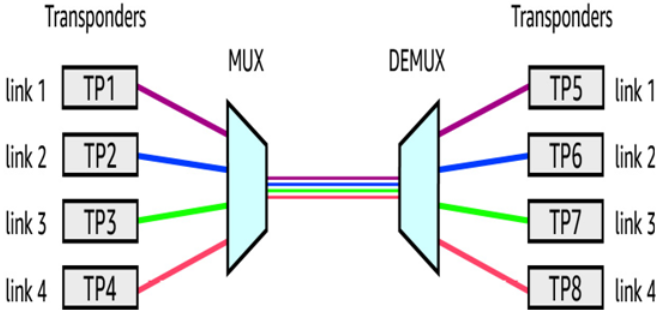
MULTIPLE INPUT MULTIPLE OUTPUT (MIMO) – Understanding Network and Security for Far-Edge Computing
MIMO is a method of increasing the effective capacity of a radio link by deliberately exploiting multipath propagation. This is typically accomplished via the use of multiple transmitters and receivers on both sides 6:
6 Some implementations have a single antenna on one side and multiple antennas on the other.

Figure 3.16 – MIMO exploiting multipathing via reflection
Multiplexing
Duplexing is about splitting up a single conversation between transmit and receive functions – but the two people talking on the channel are the same. Multiplexing, on the other hand, is about bundling up many two-party conversations so that they can all share one link. Many networks have an expensive point of aggregation that many users need to share for efficiency. Undersea cables between countries or point-to-point microwave links across a city are some examples.
Occasionally, multiplexing is something that gets added to a technology long after the original transmission medium was thought to be fully utilized. Digital Subscriber Line (DSL) is an example of this. Telco customers started demanding broadband internet access long before fiber optic cables were run to their neighborhoods, let alone to their houses. In many areas, those old copper telephone lines for the Plain Old Telephone service (POTS) network were run to the same places decades ago. DSL is a technique that multiplexes an additional analog signal onto the old POTS phone lines, but because it is outside the range of human hearing, you could still make a phone call and never notice.
Wave division multiplexing (WDM)
WDM is multiplexing with channelization based on wavelength. It often corresponds to colors of visible light when used on fiber-optic networks.
Consider a phone call from New York to London. At some stage, your conversation is getting funneled to an undersea fiber-optic cable traversing the Atlantic Ocean. Lots of individual phone calls happen at once over that big fat pipe, yet they do not interfere with each other. The voice call is converted into a specific color of laser light by a transponder and sent, along with many other colors, across the same fiber-optic cable by a device called a muxer. On the other end, a demuxer distributes the colors to transponders, which convert the signal back to voice:

Figure 3.17 – WDM
Time-division multiplexing (TDM)
TDM is a method of transmitting multiple digital signals over a single channel or link by dividing the time available for transmission into distinct time slots. Each signal is assigned a specific time slot, and the signals are transmitted sequentially, one after the other. This allows multiple signals to share the same physical channel, effectively increasing the capacity of the channel.
TDM is often used in telecommunications to transmit multiple phone calls over a single telephone line, allowing multiple conversations to take place simultaneously. It is also used in other types of communication systems, such as broadband networks and data centers, to transmit multiple data streams over a shared connection.
In TDM systems, the time slots are typically assigned using a specific pattern, such as a fixed schedule or a round-robin approach, to ensure that each signal gets an equal share of the available time. TDM is generally less efficient than other multiplexing techniques, such as WDM, but it is easier to implement and can be used in a wide range of applications.
You may also like
Archives
- August 2024
- July 2024
- June 2024
- May 2024
- April 2024
- March 2024
- February 2024
- January 2024
- December 2023
- November 2023
- October 2023
- September 2023
- August 2023
- July 2023
- May 2023
- April 2023
- February 2023
- January 2023
- November 2022
- October 2022
- September 2022
- August 2022
- July 2022
- June 2022
- May 2022
- April 2022
- December 2021
- November 2021
- October 2021
- September 2021
- June 2021
Calendar
| M | T | W | T | F | S | S |
|---|---|---|---|---|---|---|
| 1 | 2 | |||||
| 3 | 4 | 5 | 6 | 7 | 8 | 9 |
| 10 | 11 | 12 | 13 | 14 | 15 | 16 |
| 17 | 18 | 19 | 20 | 21 | 22 | 23 |
| 24 | 25 | 26 | 27 | 28 | 29 | 30 |
| 31 | ||||||
Leave a Reply